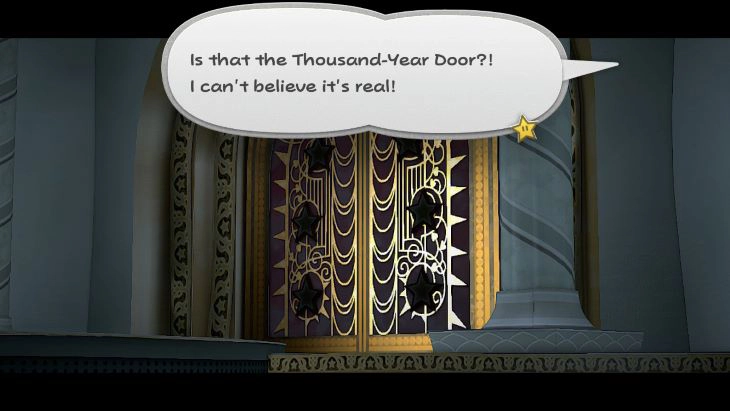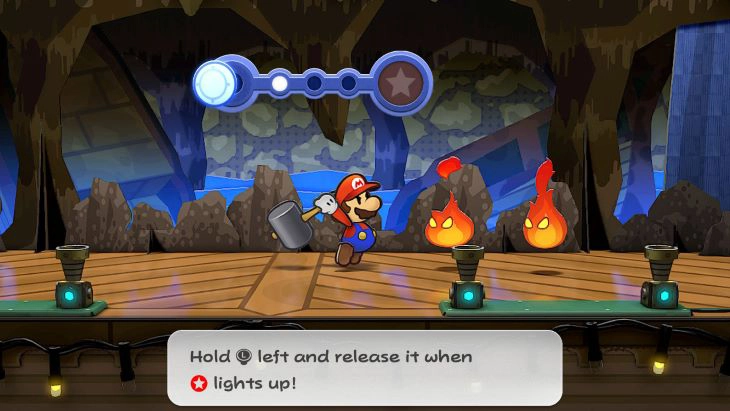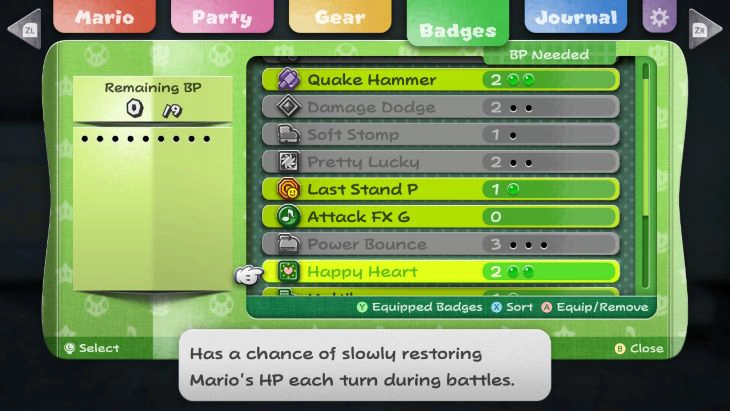
Not even a full year ago, Nintendo re-released Super Mario RPG for people to experience again after its release on the Virtual Console in 2016. And yet, in another shocking turn of events, Nintendo has brought back Paper Mario: The Thousand Year Door for the first time since its initial release 20 years ago. Looked upon as a classic Mario RPG experience and a quintessential Paper Mario title, The Thousand Year Door has a lot of excitement behind it. But is this remake worth jumping into, both for the veterans and new players?
Paper Mario: The Thousand Year Door starts with a storybook opening, telling the tale of a town that was destroyed by a large cataclysm. A new town was eventually built where that previous town stood, and rumors started to spread about an ancient city underground that held a legendary treasure. This rumor is eventually found out by Princess Peach and a mysterious group known as the X-Nauts.

The Thousand Year Door was thought to be just a myth, until Mario and Goombella stumble upon it underground.
The story is your standard Mario tale: Princess Peach has been kidnapped, and she needs your help to save her. But along with rescuing Peach, you also have to collect the Crystal Stars using the map that Peach sent to you. However, things take a darker turn as you learn more about the X-Nauts that took Peach and what their goal is. While the story is a simple one, it is solid and largely held up thanks to the wonderful writing.
Much like Super Mario RPG, the writing for The Thousand Year Door takes a more comedic approach. While there are dark and serious moments throughout the story, the game doesn’t linger too long in those moments without cracking a joke. Perhaps for those looking for a more serious tone, this may be a downside. But amidst the sea of serious JRPGs, The Thousand Year Door is a welcome treat.
After a certain point in the game, you’ll unlock access to a billboard known as the Trouble Center. This billboard is where characters ask for assistance with any issues they may be having and acts as your side quest hub. The side quests are your run of the mill quests, where you have to find a specific item or perform an action for a character. Outside of an extra source for coins, should you be running low, there isn’t much to be missed with these quests.
Paper Mario: The Thousand Year Door is a turn-based RPG that allows you to control Mario and one other team member in battle. You have a plethora of characters to choose from for your team with the ability to swap between members at any time. Although the combat is a bit simplistic, there are some customization aspects when it comes to the moves you want to have available in battle using badges. Outside of battles, you’ll navigate across different lands in order to collect the Crystal Stars, completing puzzles and platforming along the way. You’ll also be juggling between characters in the overworld, as there are certain obstacles that can only be cleared using specific characters, such as a switch that needs to be hit at the right time, or a crack in the wall that has to be blown up.
Before you enter combat, you and the enemy both have the chance to land an initial attack. If you jump on an enemy or hit them with a hammer, you’ll start off the battle attacking with that move. However, certain enemies are immune to certain attacks, and there are even some enemies that will deal damage to you if you jump on them (such as enemies with spikes on their heads). And just as you can get a bit of an edge at the beginning of battles, so can your enemies, if they happen to land a hit on you before the battle begins. After any initial attacks occur, you will always go first and you can choose to attack (either jumping or using your hammer), use an item, or use a tactic (defending or running from battle).

With every attack, you’ll have to perform a quick time event in order to successfully attack your opponent.
Jumping and using your hammer are both basic attacks that don’t consume FP, or flower points. However, as you progress, you’ll unlock stronger jump and hammer attacks that do require FP to use. Your partner likewise has a basic attack that they can use along with a skill that requires FP. For the skills that require FP, you’ll have to do quick time events with specific buttons, whether it’s holding a button until a light flashes or mashing a button until a meter fills up. These quick time events aren’t hard to fulfill, as the game gives you plenty of time to do them. But if you do end up failing the quick time events, your attack will also fail, resulting in a wasted turn.
As you fight against enemies, you’ll slowly gain an audience that is watching the battle unfold. As you land hits, you’ll gain star points, which will fill up your star gauge. Each level of your star gauge is dedicated to a specific special attack, ranging from healing skills to hard hitting AOEs. With each Crystal Star you earn, you’ll gain a new special attack that can be used.
Battles are simple to play through and don’t require too much preparation or strategy. Most of the battles you’ll be facing will be against mobs, which will be taken out with a couple of moves. Boss battles do take a bit longer, but aren’t much more difficult than regular enemies.
There are a vast amount of characters that you’ll be able to bring along with you on the journey. Each partner has their own ability that interacts with the environment, which encourages you to play around with each character. You are able to go through the game with any of the characters, although some characters do feel better than other based on whether their skills hit multiple enemies or just one. However, you are able to upgrade your partners so that you aren’t outpacing them too much as you increase your own health and skill pool.
The leveling system in Paper Mario is unique in that with each “level up”, you can choose to increase your health, your flower points (used for skills), or your badge points (used to equip badges). Nothing else is increased, like your attack, defense, or speed, so there’s not much use in grinding. That being said, you can increase your attack and defense in battle using items or your partner’s skills. With each level up, you also have your health, FP, and star gauge refilled.

As you progress through the story, you’ll unlock several badges with varying effects, such as new skills or increased stats.
Badges allow you to use specific skills in battle, and some can also act as passive skills. Badges can be found throughout the game by exploring or purchasing them in stores, so it’s easy to end up missing some of them if you’re not looking close enough. However, you can only equip a certain amount of badges based on their BP cost. You can increase your BP level whenever you level up, which can allow you to use some of the better badges that cost more to equip.
Along the way, you’ll also unlock special “curses” that allow you to traverse to areas of the map otherwise closed off to you. These curses are locked in chests that are holding malevolent spirits who are just waiting to be free. With each spirit free, they will give you a curse to change your body into different forms, such as an airplane or a boat. These are cute ways to call back to the paper craft aspect of the game while also mixing up the gameplay a bit.
Given the title, Paper Mario: The Thousand Year Door, the aesthetics for the game lean heavily into paper crafts. Most characters will be 2D paper cutouts that bend and wabble around much like paper does. When it comes to environments and large creatures, rather than going the 2D route, these are displayed as 3D dioramas. The work that was put in to make each location is amazing. Even down to the UI, the attention to detail is great and a treat to take in.
Along with the art, the music is just as great. Those familiar with the music of Mario will recognize variations of some popular songs to fit Paper Mario, as well as it’s titular song that plays right at the beginning. When it comes to the music unique to this title, the songs are bright, captivating, and unique in their own way. A lot of the songs take on a band feel, with plenty of horns and piano to fill the air. But there’s also a nice mix of orchestral pieces, and even some rock pieces to emphasize the important moments.
When it comes to the voices of the characters, the voices are more noises, similar to how the animals in Animal Crossing talk. Each character has their own tone, which is charming like everything else in the game. While voice acting would be nice, the game does make up for the lack with using the sounds of the environment and characters to its advantage.
Paper Mario: The Thousand Year Door is an experience that any fan of RPGs or Mario should experience at least once. Whether you’re a veteran of the series, or this is your first game, it’s easy to jump into and get into the swing of things. And don’t let the fact that this is a 20 year game deter you, as it has aged wonderfully and feels great to play. For those looking for a challenge, you’ll find yourself breezing through this game. But the character that this game exudes leaves one with a smile on their face.
Rating: 9/10.